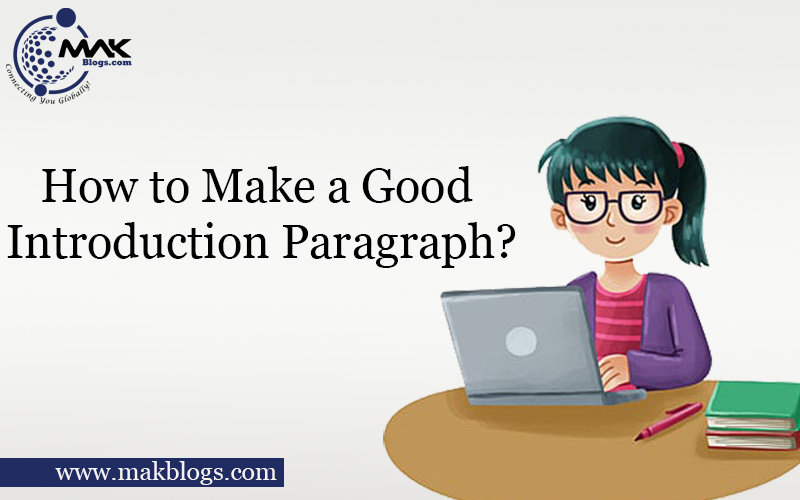Table of Contents
ToggleQuick Overview of “How to Make a Good Introduction Paragraph?”
Mastering creating a captivating introduction paragraph, as explored in this guide on “How to make a good introduction paragraph?” is essential for magnetic readers. Every element is pivotal, from crafting an attention-grabbing hook and providing contextual background information to formulating a clear thesis statement. Integrating techniques like thought-provoking questions and compelling anecdotes enriched with LSI keywords ensures engagement and search engine visibility. Examples of successful introductions in various content types emphasize the importance of this skill. Google’s optimization considerations are addressed, and common FAQs provide insight. Ultimately, crafting an exceptional introduction is an art that merges creativity and strategy, inviting readers on an immersive journey from the outset.
How to Make a Good Introduction Paragraph?
Introduction
When it comes to “How to make a good introduction paragraph?” whether it’s an essay, article, blog post, or even a marketing piece, the importance of a well-crafted introduction paragraph cannot be overstated. An introduction paragraph serves as the gateway to your content, setting the tone, capturing the reader’s attention, and providing a sneak peek into what lies ahead. In this write-up, we will delve deep into crafting a compelling introduction paragraph that keeps readers hooked from the very start. From understanding the critical components to utilizing effective strategies, we’ll cover every aspect to ensure you master creating an exceptional introduction.
Understanding the Crucial Components
Before diving into the intricacies of crafting an introduction paragraph, it’s important to understand the fundamental components that make up this essential segment of your content. These components collectively work to create an inviting and informative introduction.
Hook: Captivating Your Audience
Engaging Readers Right from the start, embarking on crafting a compelling introduction paragraph begins with a skillful turn – the gateway to your content’s universe. Imagine your hook as the magical key that unlocks readers’ Curiosity and ushers them into your world of words. This guide unveils various techniques, from thought-provoking questions to vivid descriptions designed to seamlessly incorporate the essence of “How to make a good introduction paragraph?”
Let’s explore these captivating strategies:
- Pose a Provocative Question: Begin your introduction with a question that ignites Curiosity, like “Have you ever wondered how to make a good introduction paragraph that captures hearts and minds?”
Example: Are you ready to discover the secrets behind crafting introduction paragraphs that leave a lasting impact?
- Invoke the Power of Anecdotes: Narrate a short story or personal experience related to introductions, such as “Once, a single captivating sentence transformed an ordinary article into a viral sensation.”
Example: Imagine a world where one sentence could elevate an average piece of writing into an online phenomenon.
- Employ a Thought-Provoking Quote: Start with a quote that sparks thought and resonates with the theme of introductions, like “Ernest Hemingway once said, ‘The first draft of anything is garbage.'”
Example: “The first draft of anything is garbage,” remarked the legendary Ernest Hemingway, shedding light on the transformative journey that crafting introductions can be.
- Highlight the Problem-Solution Approach: In your introduction, address a common problem and hint at a solution, such as “Struggling to engage readers from the outset? Here’s how to make a good introduction paragraph?”
Example: Are you grappling with the challenge of captivating readers in those crucial initial moments? Fear not; we’ll uncover the secrets of creating introductions that command attention.
Background Information: Contextualizing Your Content
Before diving headfirst into the heart of your content, laying down a foundation of pertinent background information is essential. This groundwork offers your readers a compass to navigate the upcoming discussions, ensuring they can fully grasp the value you will deliver.
Let’s explore the crucial role of background information in crafting an introduction that resonates.
Picture this: You’re about to journey through a vast, intricate landscape of ideas. Let’s lay the groundwork with relevant background information to ensure you navigate this terrain with confidence and understanding. Here’s how:
- Establish the Setting: Begin by briefly introducing the Context of your topic. This sets the stage and ensures readers are aligned with the subject matter.
Example: Ineffective communication, understanding how to make a good introduction paragraph is akin to setting the scene for a captivating performance.
- Highlight Key Concepts: Identify and highlight key concepts or terms that will be pivotal to comprehending your content. This serves as a roadmap for readers.
Example: Before we delve into the techniques of creating introductions that leave an impact, let’s illuminate the core concepts that underpin this crucial aspect of content creation.
- Offer Historical Background: If relevant, provide a brief historical perspective. This adds depth and Context, allowing readers to see the evolution of the topic.
Example: The practice of crafting compelling introduction paragraphs dates back centuries, evolving from traditional storytelling to modern techniques in today’s digital landscape.
Thesis Statement: Guiding Your Content’s Purpose
Imagine the thesis statement as the compass that guides your content’s journey, ensuring every word contributes to a central idea. This concise declaration serves as a roadmap for your readers, giving them a clear preview of what’s in store.
Let’s uncover the art of constructing a robust thesis statement that aligns seamlessly with “How to make a good introduction paragraph?”
Now that the landscape of your introduction is set, it’s time to unveil the heart of your content – the thesis statement. Picture it as a beacon that illuminates the path ahead, signaling the destination of your reader’s journey. Here’s how to craft a thesis statement that resonates:
- Clarify the Central Idea: Start by distilling your content’s primary focus into a single, clear sentence. This sentence encapsulates the essence of your entire piece.
Example: At the heart of mastering how to make a good introduction paragraph lies the ability to create a powerful hook that captivates and sets the stage for engaging content.
- Be Specific and Precise: Ensure your thesis statement is specific rather than vague. Pinpoint exactly what aspect of introductions you’ll be exploring.
Example: In this guide, we’ll dissect the components of effective introductions, revealing the strategies that enhance reader engagement and retention.
- Address the “Why”: Delve into why your topic is relevant or essential. This adds depth and Context to your thesis statement.
Example: Understanding how to make a good introduction paragraph is not just a skill for writers – it’s a doorway to fostering connections and leaving a lasting imprint on your readers.
Effective Strategies for Crafting an Introduction Paragraph

Now that we have a solid grasp of the components that constitute a strong introduction paragraph let’s explore some tried-and-true strategies to help you create introductions that captivate your audience.
1. Pose a Thought-Provoking Question
Begin your introduction with a question that stimulates your readers’ Curiosity and encourages them to seek answers in the following content.
For example: Have you ever wondered how a simple introduction paragraph can make or break your entire piece of writing?
2. Share an Anecdote
Regarding “How to make a good introduction paragraph?” Narrating a brief story or personal experience related to your topic can instantly connect with your readers and make your content more relatable.
For instance: Standing at the edge of the cliff, the vast expanse of the ocean before me, I couldn’t help but reflect on the parallels between life’s uncertainties and the uncharted waters that stretched before me.
3. Present a Surprising Fact
Shocking or intriguing facts can grab your readers’ attention and motivate them to explore the subject further.
For example: Did you know that the average attention span of an online reader is now shorter than that of a goldfish?
4. Use a Quotable Quote
In the Context of “How to make a good introduction paragraph?” A well-chosen quote from a relevant source can add credibility and depth to your introduction. It should resonate with your topic and offer a fresh perspective.
For instance: The maxim “The secret of getting ahead is getting started” is attributed to Mark Twain. This wise advice is applicable even when writing captivating beginning paragraphs.
Utilizing LSI Keywords for Enhanced Engagement
In content creation, using Latent Semantic Indexing (LSI) keywords can significantly enhance your writing’s search engine visibility and reader engagement. Semantically relevant terms, or LSI keywords, aid search engines in comprehending the Context of your material. Here’s how you can incorporate them effectively:
1. LSI-Infused Headings
Incorporate LSI keywords into your headings to signal your content’s relevance to readers and search engines.
For instance: Mastering the Art of Writing a Good Introduction Paragraph: Key Strategies for Engaging Content
2. Naturally Blend LSI Keywords in Content
Integrate LSI keywords seamlessly throughout your content to provide a comprehensive and contextually rich reading experience.
For example, in an article about crafting introductions: In the realm of “How to make a good introduction paragraph?” Crafting a compelling introduction paragraph involves more than just a catchy hook. To truly engage readers, it’s essential to consider the background information you provide and the strength of your thesis statement.
Examples of Stellar Introduction Paragraphs
Let’s dive into a few examples that showcase how these strategies can be applied to different types of content:
1. Blog Post: Travelogue
Have you ever stepped into a place where time seems to stand still? Imagine walking through narrow cobbled streets that whisper tales of ancient civilizations. Welcome to the hidden gem that is the city of Pompeii. In this travelogue, we’ll uncover the mysteries buried beneath the volcanic ash and explore the rich history that pulses through its ruins.
2. Essay: Climate Change
Wildfires that are out of control, melting glaciers, and increasing sea levels are the planet’s urgent signals to humanity. As we stand at the crossroads of history, it’s time to heed this call for action. This essay delves into the alarming reality of climate change, its root causes, and the collective efforts required to secure a sustainable future for future generations.
The Role of Google in Crafting Effective Introductions
Regarding “How to make a good introduction paragraph?” Google’s algorithm places significant emphasis on user experience and relevance. To ensure your introduction paragraph aligns with Google’s guidelines, it’s essential to:
1. Optimize for Featured Snippets
2. Mobile-Friendly Formatting
The link “https://developers.google.com/search/docs/fundamentals/creating-helpful-content” offers insights into crafting web content that meets user needs and provides value. Although not specific to introductions, it aligns with creating engaging and informative introduction paragraphs that resonate with readers and enhance their experience.
Conclusion
In summary, fashioning an engaging introduction paragraph seamlessly combines creativity, strategic thinking, and an innate grasp of your audience’s anticipations. As you put into action the meticulously outlined strategies within this guide and delve into the intricacies of effective introductions, you’ll find yourself well-prepared to produce content that resonates powerfully right from that opening sentence. Remember, a finely honed introduction isn’t merely an entrance; it serves as an open invitation to embark on a journey of discovery – an exploration guided by the essence of “How to make a good introduction paragraph?”
FAQs Related to “How to Make a Good Introduction Paragraph?”
Certainly; here are a few brief examples of good essay introduction paragraphs:
Startling Fact: “Over 60% of students struggle with time management, making it a critical skill for academic succ
Anecdote: “Stood before ancient ruins, I realized this experience would forever shape my perspective on history.”
Provocative Question: “What if subconscious biases influence every decision you make?”
Eleanor Roosevelt once stated, “Those who believe in the beauty of their dreams belong to the future.”
Historical Context: “During the Industrial Revolution, economies and lives underwent profound transformations.”
Narrative Preview: “Imagine a world where technology erases geographical boundaries.”
Read more in the above post titled “How to make a good introduction paragraph?”
It is a tool or piece of software that automatically generates introduction paragraphs for various forms of content, such as essays, articles, or reports. It uses algorithms and templates to generate opening paragraphs that grab readers’ attention and provide Context for the following content. Read more in the above post titled “How to make a good introduction paragraph?”
To start an essay introduction, consider using attention-grabbing techniques like a thought-provoking question, a surprising fact, an anecdote, a relevant quote, or a concise statement of the topic’s significance. Read more in the above post titled “How to make a good introduction paragraph?”
To write a good essay introduction, begin with a hook that captivates, provide background context, and present a clear thesis statement that outlines the essay’s primary focus and purpose. Read more in the above post titled “How to make a good introduction paragraph?”
When writing an introduction about yourself, start with a concise and engaging opening, mention your name and background, share relevant achievements or interests, and provide a glimpse of your personality or aspirations. Read more in the above post titled “How to make a good introduction paragraph?”









